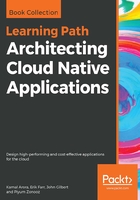
Embraces disposable architecture
Not enough emphasis is placed on the Big R in conversations about cloud-native. Independent DURS ultimately comes up in every discussion on cloud-native concepts; to independently Deploy, Update, Replace, and Scale. The focus is inevitably placed on the first and the last, Deploy and Scale, respectively. Of course, Update is really just another word for Deploy, so it doesn't need much additional attention. But Replace is treated like a redheaded stepchild and only given a passing glance.
I think this is because the Big R is a crucial, higher-order concept in cloud-native, but many discussions on cloud-native are down in the technical weeds. There is no doubt, it is essential that we leverage disposable infrastructure to independently deploy and scale bounded isolated components. But this is just the beginning of the possibilities. In turn, disposable architecture builds on this foundation, takes the idea of disposability and replacement to the next level, and drives business value further. At this higher level, we are driving a wedge in monolithic thinking at the business level.
The monolith is etched on our brains and permeates our way of thinking. It leads us to architectural and business decisions that may be optimal in the context of the monolith, but not in the context of cloud-native. Monolithic thinking is an all or nothing mindset. When something has to be all or nothing, it frequently leads us to avoid risk, even when the payoff could be significant if we could only approach it in smaller steps. It just as frequently drives us to take extreme risk, when it is perceived that we have no choice because the end game is believed to be a necessity.
Disposable architecture (aka the Big R) is the antithesis of monolithic thinking. We have decomposed the cloud-native system into bounded isolated components and disposable infrastructure accelerates our ability to deploy and scale these components. One rule of thumb, regarding the appropriate size of a component, is that its initial development should be scoped to about 2 weeks. At this low level of investment per component, we are at liberty to experiment with alternatives to find an optimal solution. To put this in business terms, each experiment is the cost of information. With a monolith, we are more likely to live with a suboptimal solution. The usual argument is that the cost of replacement outweighs the ongoing cost of the suboptimal solution. But in reality, the budget was simply blown building the wrong solution.
In his book, Domain Driven Design: Tackling Complexity in the Heart of Software (http://dddcommunity.org/book/evans_2003/), Eric Evans discusses the idea of the breakthrough. Teams continuously and iteratively refactor towards deeper insight with the objective of reaching a model that properly reflects the domain. Such a model should be easier to relate to when communicating with domain experts and thus make it safer and easier to reason about fixes and enhancements. This refactoring typically proceeds at a linear pace, until there is a breakthrough. A breakthrough is when the team realizes that there is a deep design flaw in the model that must be corrected. But breakthroughs typically require a high degree of refactoring.
Breakthroughs are the objective of disposable architecture. No one likes to make important decisions based on incomplete and/or inaccurate information. With disposable architecture, we can make small incremental investments to garner the knowledge necessary to glean the optimal solution. These breakthroughs may require completely reworking a component, but that initial work was just the cost of acquiring the information and knowledge that led to the breakthrough. In essence, disposable architecture allows us to minimize waste. We safely and wisely expend our development resources on controlled experiments and in the end get more value for that investment. We will discuss the topic of lean experiments and the related topic of decoupling deployment from release in Chapter 6, Deployment. Yet, to embrace disposable architecture, we need more than just disposable infrastructure and lean methods; we need to leverage value-added cloud services.